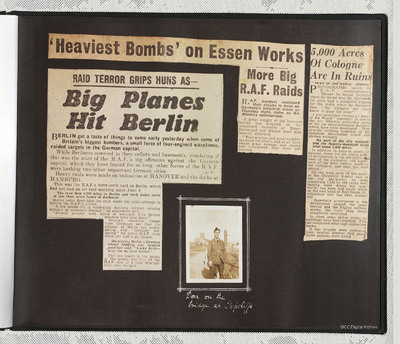Bombing newspaper cuttings
Title
Bombing newspaper cuttings
Description
Three cuttings, big planes hit Berlin, heaviest bombs on Essen works and 5000 acres of Cologne are in ruins.
At bottom a three-quarter length image of an airman wearing tunic and side cap captioned 'Don on the bridge at Topcliffe'.
At bottom a three-quarter length image of an airman wearing tunic and side cap captioned 'Don on the bridge at Topcliffe'.
Spatial Coverage
Language
Format
Three newspaper cuttings and one b/w photograph mounted on an album page
Conforms To
Is Part Of
Publisher
Rights
This content is available under a CC BY-NC 4.0 International license (Creative Commons Attribution-NonCommercial 4.0). It has been published ‘as is’ and may contain inaccuracies or culturally inappropriate references that do not necessarily reflect the official policy or position of the University of Lincoln or the International Bomber Command Centre. For more information, visit https://creativecommons.org/licenses/by-nc/4.0/ and https://ibccdigitalarchive.lincoln.ac.uk/omeka/legal.
Identifier
PWickhamHW19010003
Collection
Citation
“Bombing newspaper cuttings,” IBCC Digital Archive, accessed November 8, 2024, https://ibccdigitalarchive.lincoln.ac.uk/omeka/collections/document/40711.
Item Relations
This item has no relations.

